Renault deal was deathblow to AMC
Q: Greg, I appreciate your nostalgia car articles as they bring back fond memories. I’m glad AMC made your recent Top 10 Muscle Car list with the wild little 390 American Scrambler back in 1968.
However, as AMC failed as a car company, where do you feel AMC took the wrong turn? I feel it was when they got into an agreement with Renault. How about you? Some of the Renault cars were good, others not so good. Just wanted to write you a letter letting you know I enjoy the articles and make my day brighter reading your memories and how the manufacturers used auto racing to promote the products (i.e. win on Sunday, sell on Monday). Jim Davis, retired near Lancaster, Pa.
A: Jim, thanks so much for your letter and kind words. I was a big AMC fan and I’ve owned five AMC cars in my days, mostly for AMC’s reliability when selling newspaper advertising over the road for many years.
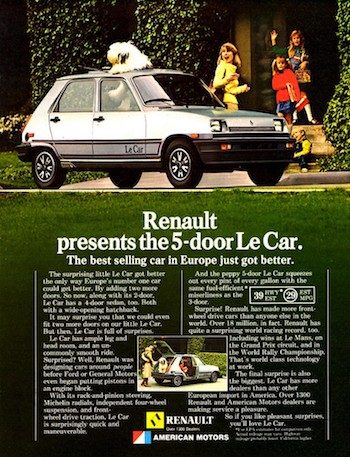
The Renault LeCar was a sub-compact that delivered 39-MPG highway and was sold at AMC dealers starting in the late 1970s. (Renault/AMC)
My first was a 1974 Hornet X (new, 258 six), then in succession a 1976 Gremlin X (new, 258 six), a 1979 Spirit with four-cylinder VW engine (used leftover), and then a 1974 Matador sedan (used, 304 V8) that I traded two pinball machines for. The fifth is sitting in my garage right now, a 1980 AMC Concord DL, 2-door, with just 27,000 original miles. She just went through state inspection with flying colors.
To get to your question, through the early 1960s AMC was doing well selling its brand of compact economy, especially cars like the Rambler American. By the mid-1960s, larger was better and muscle cars were the “in” thing. AMC responded as best it could, and thanks to the larger Ambassadors and Matadors and the new line of Gremlins, Hornets and Marlins, sales were decent. Then Javelin and AMX arrived, and things started looking even better.
As for racing, American Motors came into NHRA Pro Stock Drag Racing in 1974-75, albeit a bit late, with two AMC Hornet X machines. One was the Booth & Aarons entry driven by Wally Booth and second by the team of Dick Maskin and Dave Kanners, driven by Kanners. Booth won national events in his Hornet, while Kanners had strong finishes at several NHRA national events.
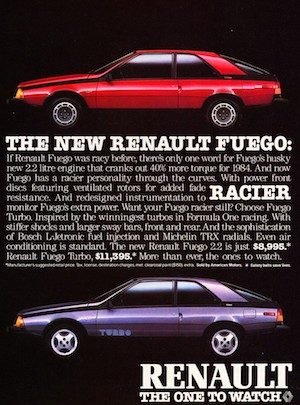
The 1984 AMC Renault Fuego was for the sports car enthusiast and came with 4-cylinder turbo power. (Renault/AMC)
Roger Penske also took AMC to new heights, winning several SCCA road racing Trans Am titles in the early 1970s with a Javelin, and then followed with NASCAR Winston Cup (now Cup) victories in a factory backed AMC Matador.
However, not everything was rosy at AMC as the company struggled financially. Even after purchasing Jeep in 1970, which helped sales but not the bottom line, AMC needed a partner with monies to invest. That’s when Renault of France entered the picture as a “quarter-partner” in 1978, and then upped the ante to 49-percent interest by 1983.
The Renault-based AMC cars were okay, specifically the 1983 Alliance, which received the Motor Trend “Car of the Year” award. I also remember the 1984 sports car called the Fuego, which was nice, and the LeCar, a subcompact that sold okay but was not one of my favorites.
The Renault deal fizzled badly however when politics, lack of credit, and even an assassination stopped the AMC train dead in its tracks. Renault’s CEO Georges Besse was killed in 1986 in Paris by a militant group upset with many job layoffs and Renault’s building of a new plant in Canada. Two militants rode up on motorcycles and shot him four times, killing him instantly.
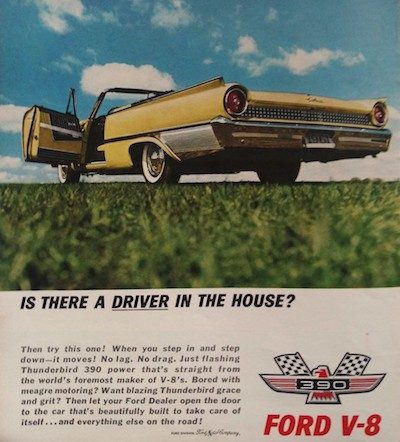
The carbs on Ford’s first tri-power were Holley carbs, not Autolite carbs. Introduced in 1961 for the new 390-cubic-inch engine, the tri-power setup consisted of three two-barrel Holley carburetors that pushed horsepower to 401, the most of any manufacturer that year. (Ford)
The new Renault CEO, Raymond Levy, wanted out immediately (can you blame him), and this is when Chrysler stepped in. By March of 1987 Chrysler agreed to buy all of Renault’s stock in AMC and then bought all remaining AMC shares. This resulted in Chrysler’s new Jeep-Eagle division that put an end to the AMC Company we once knew. To this day the Jeep brand is one of America’s most popular vehicles being sold under Stellantis ownership, a multinational corporation that was formed by the merger of Fiat Chrysler Automobiles (FCA) and PSA Group in 2021. Stellantis owns a total of 15 worldwide vehicle brands.
Thanks again for the nice letter, and I agree with you that the Renault co-op was the start of AMC’s final plunge into automotive obscurity.
Holley and Autolite carburetors not identical twins
Q: Greg, I found a column you did online about the Ford 289 High-Performance 271 HP engine that caught my interest. Every factory 289 Hi-Po I ever looked at came with a Ford Autolite carburetor and not a Holley as you mentioned.
The GT 350 did have a Holley carburetor and a high-rise intake, but it was installed by the Shelby factory resulting in 306-horsepower.
Can you update your Holley carb information on these engines? Thanks much, as I enjoy your work. Steven Tallman, Kansas City, Kansas.
A: Steven thanks very much for your comments and update on the Autolite Ford carbs. The Ford Autolite carburetors came about in the later 1950s as a replacement for the Stromberg and Holley carburetors that Ford was using on their engines at the time.
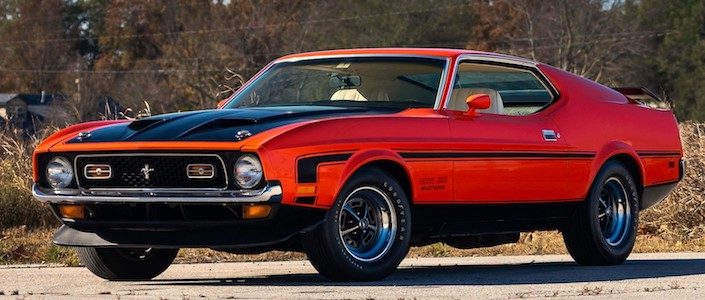
The Boss Mustang with an Autolite carburetor that fed a 351 Cleveland engine appeared only one year, in 1971. These 351C-powered Boss Mustangs are highly valued by collectors as most of the 351 Cleveland powered Mach 1 models. (Mecum Auctions)
Although I agree the factory 289 Hi-Po engines did come with the Ford developed Autolite carb, which I inadvertently called a Holley in my article, there is a reason for it. Holley and Ford worked hand in hand on carburetor development that dates to 1957 when the Autolite carb debuted on the Ford Y-block V8. Holley carburetors were similar to the Ford Autolite carbs and to this day many enthusiasts feel the Autolite and Holley are twins, although not identical twins.
Further, to be specific, Ford produced its Autolite carbs and even used Holley pieces in its production. Still, the Autolite is NOT a true Holley developed carb and I stand corrected. They may look alike, but there are differences.
Notable through the years was part interchangeability. My very first Holley 4-barrel was bolted on my ’63 Impala 283 and was given to me by a friend in 1967 that worked at the local speed shop. He told me it had some Autolite pieces in it!
As for history, the Holley Brothers, Earl and George, built their first commercial carb way back in 1907, so they’ve been around for a long time. Their first carb was a one-barrel design used on Mr. Ford’s Model T, thus the long association with Ford.
The Holley design grew into the carb of choice for all the big Ford / Mercury 1967 to 1971 muscle cars like the Boss 302, 390 Hi-Po, 428 and 429 engines, to name a few. Surprisingly, the 351 Cleveland with its excellent canted-valve cylinder heads relied on an Autolite carb that most of the performance crowd immediately replaced with a genuine, and bigger, Holley.
During the muscle car era of 1965 to 1972, each car company was closely aligned with a carburetor manufacturer. If you had a Roadrunner 383, Super Bee Hemi or GTX 440 from MOPAR, it came with a Carter AFB setup (today named, owned and marketed by Edelbrock). However, if you had a MOPAR 440 Six Pack in 1969 1/2 to 1971, it was a Holley “three-two” setup.
Over at General Motors, they used the Holley carbs on the hot stuff (LS6, 396/375, L88, etc.), but GM also used many of the Rochester Quadrajet “spread-bore” carbs and Rochester tri-power setups on its muscle cars. Nevertheless, the 427/435 Corvette tri-power was also a Holley build, as were Ford tri-powers as far back as 1961.
Hope this explains the association between Holley and Ford Autolite carbs, the latter Holley inspired but not 100% identical.
(Greg Zyla is a syndicated auto columnist who welcomes reader interaction on auto nostalgia, collector cars and motorsports at greg@gregzyla.com or at Roosevelt St., Sayre, Pa. 18840.)
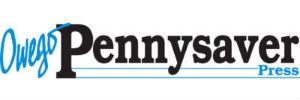
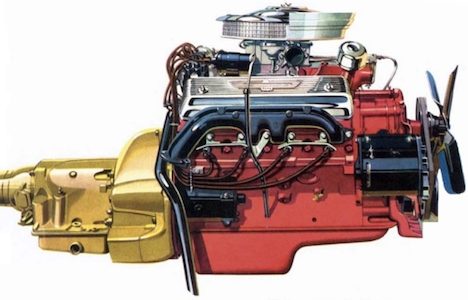

Be the first to comment on "Collector Car / Cars We Remember; AMC French Connection and Holley / Autolite ‘non-identical twins’"